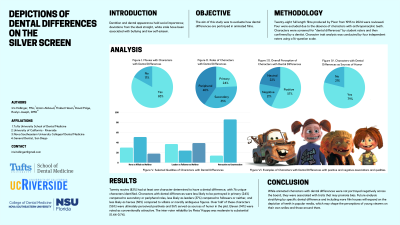Other
381 - Depictions of Dental Differences on the Silver Screen


Iris Hollinger
Pre-dental student
Other
Tufts University School of Dental Medicine
Vero Beach, Florida, United States- RJ
Roslyn Joseph, DMD
Other
San Diego, California, United States
Presenting Author(s)
Program Director(s)
Purpose: Dentition and dental appearance hold social importance; deviations from the ideal straight, white smile have been associated with bullying and low self esteem. The aim of this study was to evaluate how dental differences are portrayed in animated films.
Methods: Twenty-eight full length films produced by Pixar from 1995 to 2024 were reviewed. Four were excluded due to the absence of characters with anthropomorphic teeth. Characters were screened for “dental differences” and then assessed and classified by a dentist. Character trait analysis was conducted by four independent raters using a 16-question scale. Inter-rater reliability was evaluated using Fleiss’ kappa.
Results: Twenty movies (83%) had at least one character determined to have a dental difference, with 76 unique characters identified. Characters with dental differences were less likely to be portrayed in primary (24%) compared to secondary or peripheral roles, as leaders (37%) compared to followers, and as heroes (30%) compared to villains or morally ambiguous figures. Over half of these characters (56%) were ultimately perceived positively and 79% served as sources of humor in the plot. Eleven (14%) were rated as conventionally attractive.
Conclusion: While animated characters with dental differences were not portrayed negatively across the board, they were associated with traits that may promote bias. Future analysis including more film houses will expand on the depiction of teeth in popular media, which may shape the perceptions of young viewers on their own smiles and those around them.
Identify Supporting Agency and Grant Number:

.jpg)